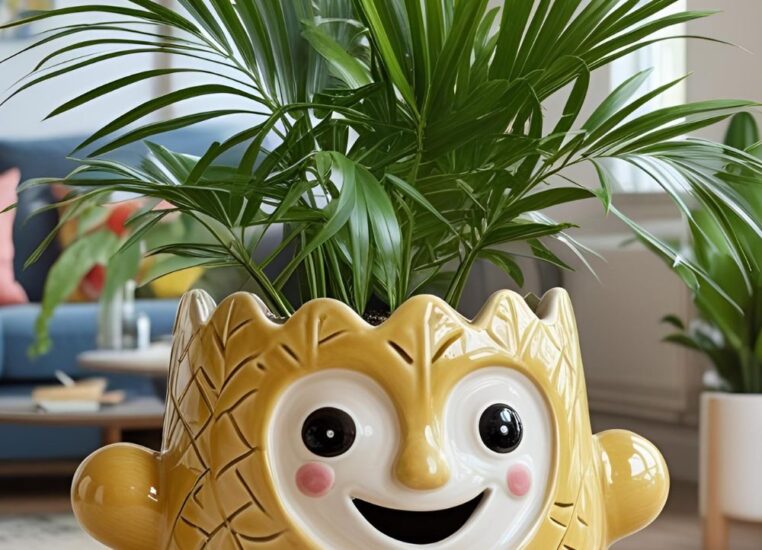Turning your home into a peaceful oasis is simpler than you might think.
Adding indoor plants to your decor is a great way to start.
They not only clean the air and make your space look better.
They also bring a sense of calm and connect you to nature.
With the right plant decor ideas, any room can become a haven.
Whether you want to update one area or do a full home transformation, plants are a great choice.
In this short post, we’ll share 11 easy tips to help you begin making your home more beautiful and peaceful.
Why Plants Transform Living Spaces
Adding indoor plants to your home can change how it looks and feels.
These plants do more than just look good. They help clean the air and make your home healthier.
More Than Just Pretty
Studies show that indoor plants are good for your health.
They clean the air by removing harmful substances. This makes the air in your home better to breathe.
Some plants can even make you feel less stressed and happier.
This is because they make oxygen and take in carbon dioxide.
This natural process improves the air and makes you feel better.
From Drab to Fab: Visual Impact of Indoor Greenery
Indoor plants can make a room look much better.
They add color, texture, and life to dull areas.
You can use them to draw attention to a specific spot or add green to a corner.
The beauty of indoor plants goes beyond looks.
They make your home feel welcoming and cozy.
| Benefits of Indoor Plants | Visual Impact | Health Benefits |
|---|---|---|
| Purify the air | Add color and texture | Reduce stress levels |
| Improve air quality | Create a focal point | Boost mood |
| Enhance aesthetic appeal | Add life to dull spaces | Improve overall well-being |
Know Your Space: Matching Plants to Your Home’s Conditions
Before picking plants, know your home’s conditions.
Look at the light and humidity levels.
Some plants love bright light, while others prefer shade.
Choose plants that fit your home’s conditions to keep them healthy and bright.
- Check your home’s light to pick the right plants.
- Think about the humidity in each room.
- Pick plants that can handle your home’s environment.
Finding Your Plant Style: From Minimalist to Jungle Vibes
Your plant style should match your home’s decor and your taste.
Whether you like a simple look or a jungle feel, there’s a plant for you.
Tips for Finding Your Plant Style:
- Start with a big, bold plant that shows your style.
- Combine different plant sizes and textures.
- Think about the colors of your plants and decor.
Indoor Plant Decor Tips at a Glance
| Tip | Description | Benefit |
|---|---|---|
| 1. Statement Plant | Choose a large, eye-catching plant. | Creates a focal point in the room. |
| 2. Hanging Plants | Use hanging baskets or macramé. | Saves space and adds visual interest. |
| 3. Bookshelf Plants | Place small plants on bookshelves. | Adds greenery to often-overlooked spaces. |
Picking Winners for Your Space
Starting your indoor garden journey begins with a visit to the plant store.
With many options, it’s key to know what to look for.
This will help you create a beautiful indoor garden.
Beginner-Friendly Plants That Are Hard to Kill
For newbies to indoor gardening, picking easy-to-care-for plants is vital. Some top beginner-friendly plants include:
- Snake Plants: Thrive in low light
- ZZ Plant: Needs little water and care
- Spider Plants: Simple to grow and share
These plants are great for beginners. They can handle a little neglect and keep growing.
Where to Shop: Beyond the Big Box Stores
Big box stores are handy for plant shopping, but they miss out on unique plants and expert advice. Specialty stores offer:
| Store Type | Benefits |
|---|---|
| Local Nurseries | Expert staff, unique plants, and a personal shopping experience |
| Specialty Plant Stores | A wide range of plants, including rare ones |
| Online Plant Retailers | Easy shopping, lots of choices, and good prices |
Exploring these different places can lead to finding new, exciting plants for your garden.
11 Ideas for Plant Decor Indoor:
Make your home look amazing with these 11 indoor plant ideas.
They turn your living space into a lush oasis.
Plus, they clean the air and make your home feel better.
Tip #1: Create a Jaw-Dropping Statement Plant Corner

Turn a corner of your home into a lush oasis.
A well-designed statement plant corner can make any room feel more vibrant and alive.
Choosing Dramatic Focal Point Plants
To create a jaw-dropping display, choose plants that make a statement.
Look for dramatic plants with unique shapes, sizes, or colors.
Some great options include:
- Fiddle Leaf Figs for their large, violin-shaped leaves
- Bird of Paradise plants for their exotic, orange flowers
- Dracaena marginata for its striking, red-edged leaves
These plants are visually striking and easy to care for. They’re perfect for a statement piece.
Styling Your Green Corner for Maximum “Wow” Factor
After picking your dramatic plants, style your corner. Here are some styling tips to boost the “wow” factor:
- Use a mix of plant sizes and textures for visual interest
- Choose a unifying theme, like a color scheme or pot style, to tie the display together
- Add decorative elements, like sculptures or pebbles, to enhance the visual appeal
Best Plants for Statement Corners
Some plants are perfect for statement corners because of their size, shape, or growth habits. Here are a few top picks:
| Plant | Description |
|---|---|
| Fiddle Leaf Fig | Large, violin-shaped leaves that add elegance |
| Bamboo Palm | Feathery fronds for a lush, tropical feel |
| Rubber Plant | Large, dark green leaves for a dramatic touch |
Tip #2: Hanging Plants That Make Ceilings Sing
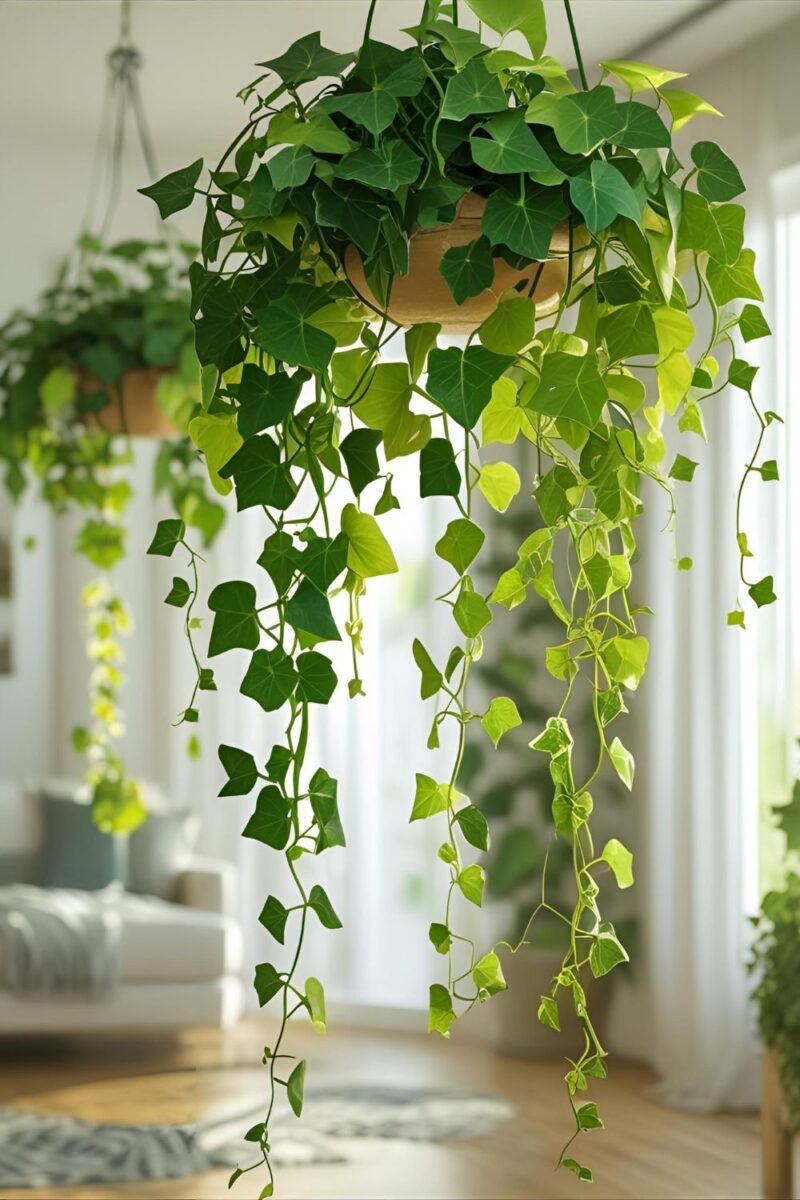
Make your ceilings pop with hanging plants.
They’re not just pretty; they also clean the air and bring calm.
Choose the right plants and hangers to turn your home into a green oasis.
Defying Gravity: Plants That Look Amazing from Above
Some plants look great from below, perfect for hanging baskets.
Trailing plants like ivy, ferns, and flowering plants such as orchids or begonias are stunning when hung. They add beauty and soften room lines.
- Ivy: A versatile, low-maintenance option that thrives in various lighting conditions.
- Ferns: Add a delicate, lush texture to your hanging displays.
- Orchids: Exotic and elegant, perfect for creating a sophisticated ambiance.
Macramé, Hooks, and Pulleys: Getting Creative with Hangers
The way you hang plants can be as decorative as the plants.
Macramé hangers add a bohemian flair. Hooks and pulleys offer a practical touch, letting you adjust plant heights easily.
| Hanger Type | Description | Best For |
|---|---|---|
| Macramé | Bohemian-inspired, handmade hangers | Adding a decorative touch |
| Hooks | Simple, versatile hanging solution | Easy installation |
| Pulleys | Adjustable hanging system | Controlling plant height |
DIY Hanging Solutions Anyone Can Make
Make your own hanging solutions for a fun DIY project. Use twine, dowels, or recycled stuff to create unique hangers. Try making a macramé hanger with cotton rope and basic knots for a simple project.
Adding hanging plants to your decor brings new interest and life to your space. Whether it’s a simple hook or a fancy macramé hanger, the right plants can make your ceilings sing.
Tip #3: Bookshelf Glow-Ups with Strategic Plant Placement

Adding plants to your bookshelves can make your living space feel like a lush oasis.
Plants bring depth and interest to your shelves, making them more visually appealing.
The Plant-to-Stuff Ratio: Finding Balance on Shelves
Decorating bookshelves with plants requires finding the right balance.
You don’t want plants to take over or get lost among books and decor.
Start with one or two statement plants and balance them with your existing decor.
Aim for a mix of heights and textures to make your display visually appealing.
For example, pair a tall, slender plant with a shorter, bushier one for contrast.
Creating Visual Stories with Plants and Objects
Bookshelves are a great way to tell a story through your decor.
Group plants with natural elements like vintage prints or river rocks for a cohesive look.
Use plants to highlight a special book or object on your shelf.
Shelf-Friendly Plants That Won’t Take Over
Not all plants are good for bookshelf decor. Look for compact, slow-growing, or easily pruned varieties.
- Succulents and cacti are low-maintenance and come in many shapes and sizes.
- Ferns and peace lilies add elegance and thrive in low light.
- Herbs like basil and mint add fragrance to your display.
Tip #4: Window Wonderlands: Sunlit Plant Displays

Sunlit windows are perfect for stunning plant displays.
Pick the right plants and style them well.
This way, you can turn your windows into bright showcases that brighten your home.
Sun-Worshipping Plants for Window Glory
For sunlit windows, choose plants that love bright, direct light.
Succulents, cacti, and orchids or geraniums are great. These plants do well in sun and add color and life to your windows.
| Plant Type | Light Requirement | Watering Needs |
|---|---|---|
| Succulents | Direct Sunlight | Low |
| Cacti | Direct Sunlight | Low |
| Orchids | Bright, Indirect Light | Moderate |
Playing with Heights: Creating Window Vignettes
To make window vignettes, mix heights and textures.
Use tall plants, hanging plants, and different sizes for depth.
Use plant stands or hanging hooks for levels and to use your window space well.
Solutions for Different Window Types
Each window type needs a special approach.
Bay windows need tall and short plants.
Small windows are best with compact or hanging plants. Think about your window’s direction and light to pick the right plants.
Tip #5: Spa Vibes: Transforming Bathrooms with Humidity-Loving Plants
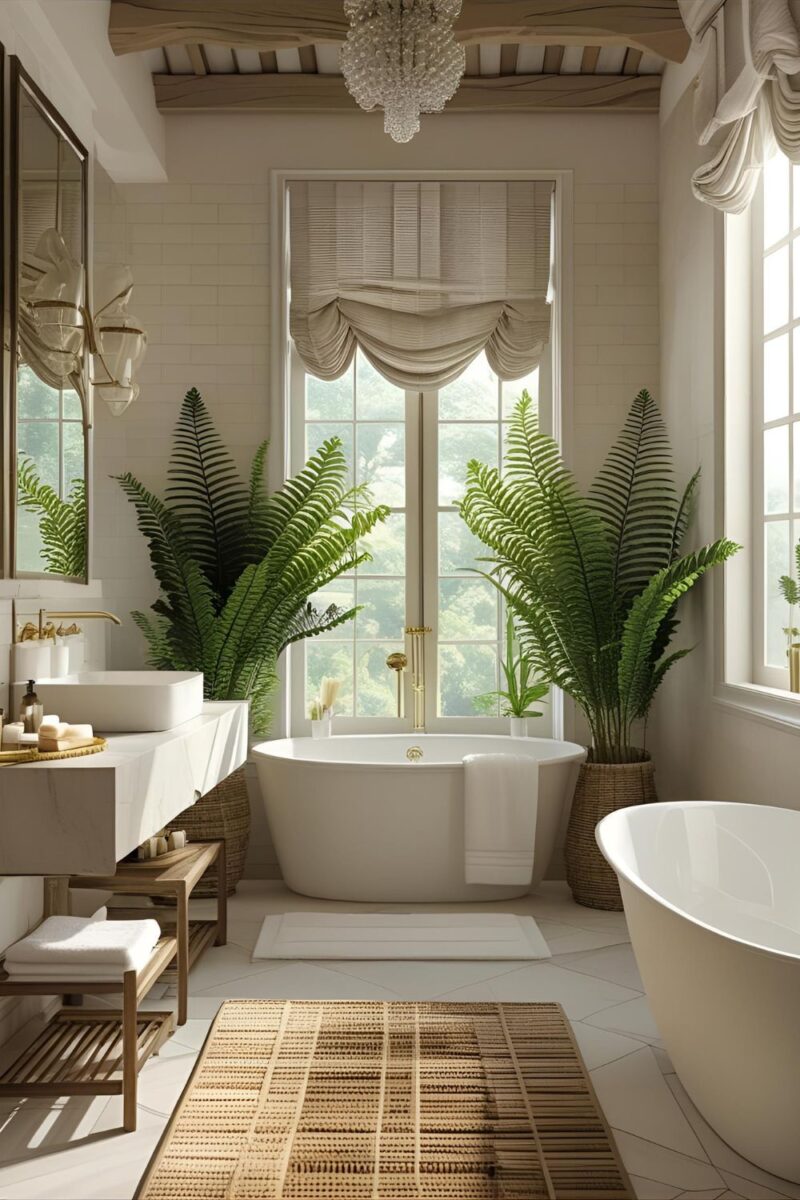
Bathrooms can be more than just places to get clean.
They can be peaceful spots with the right plants.
Adding humidity-loving plants turns this area into a cozy retreat that makes your day better.
Tropical Beauties That Thrive in Steamy Conditions
Tropical plants love humid places, making them perfect for bathrooms.
Here are some great choices:
- Orchids: These plants are exotic and elegant, loving the moist bathroom air.
- Boston Ferns: They add a lush green touch and enjoy the bathroom’s humidity.
- Peace Lilies: Peace lilies not only like humid air but also clean it up.
These plants are not just pretty. They also make your bathroom healthier by improving the air.
Small Space Solutions for Bathroom Greenery
Even tiny bathrooms can have plants. Here are some ideas:
- Hanging Planters: Hang planters above your shower or sink to save space.
- Corner Shelves: Use tiered shelves in corners to fit more plants.
- Compact Plants: Pick small plants that won’t take over the space.
Avoiding Common Bathroom Plant Mistakes
To keep your plants happy, avoid these mistakes:
- Don’t overwater: Plants in humid bathrooms might need less water.
- Check the light: Even if plants can handle low light, they need some.
- Watch the temperature: Changes in bathroom temperature can affect plants, like heated floors or cold windows.
Tip #6: Stylish Kitchen Herb Gardens

Stylish kitchen herb gardens are more than pretty.
They also make your cooking better.
Having fresh herbs nearby can make your dishes taste amazing and add a personal touch to your kitchen.
Fresh and Functional: Herb Arrangements That Impress
Creating an impressive herb arrangement is about mixing looks with function.
Start by picking herbs like basil, rosemary, and thyme. These herbs do well together and need similar care.
Tips for arranging herbs:
- Choose a mix of textures and heights to add visual interest.
- Consider the color palette of your kitchen when selecting herb varieties.
- Use a combination of pots and planters to create a layered look.
Beyond Basic Pots: Creative Containers for Culinary Plants
The right container can make your herb garden stand out. Look for creative containers that match your kitchen’s style.
Vintage tea tins, wooden planters, or hanging baskets are great options.
Make sure the containers have good drainage. This prevents the soil from getting too wet. You can also use mason jars or old colanders for a unique look.
Herbs That Both Look and Taste Amazing
Some herbs are perfect for kitchen gardens because they taste great, smell wonderful, and look good. Here are some favorites:
| Herb | Flavor Profile | Visual Appeal |
|---|---|---|
| Basil | Sweet and aromatic | Bright green leaves |
| Rosemary | Piney and herbaceous | Fragrant, needle-like foliage |
| Thyme | Subtle, slightly minty | Delicate, tiny leaves |
By adding these herbs to your kitchen garden, you’ll improve your cooking and make your kitchen look great.
Tip #7: Pot Personalities: Statement Planters That Transform Plants
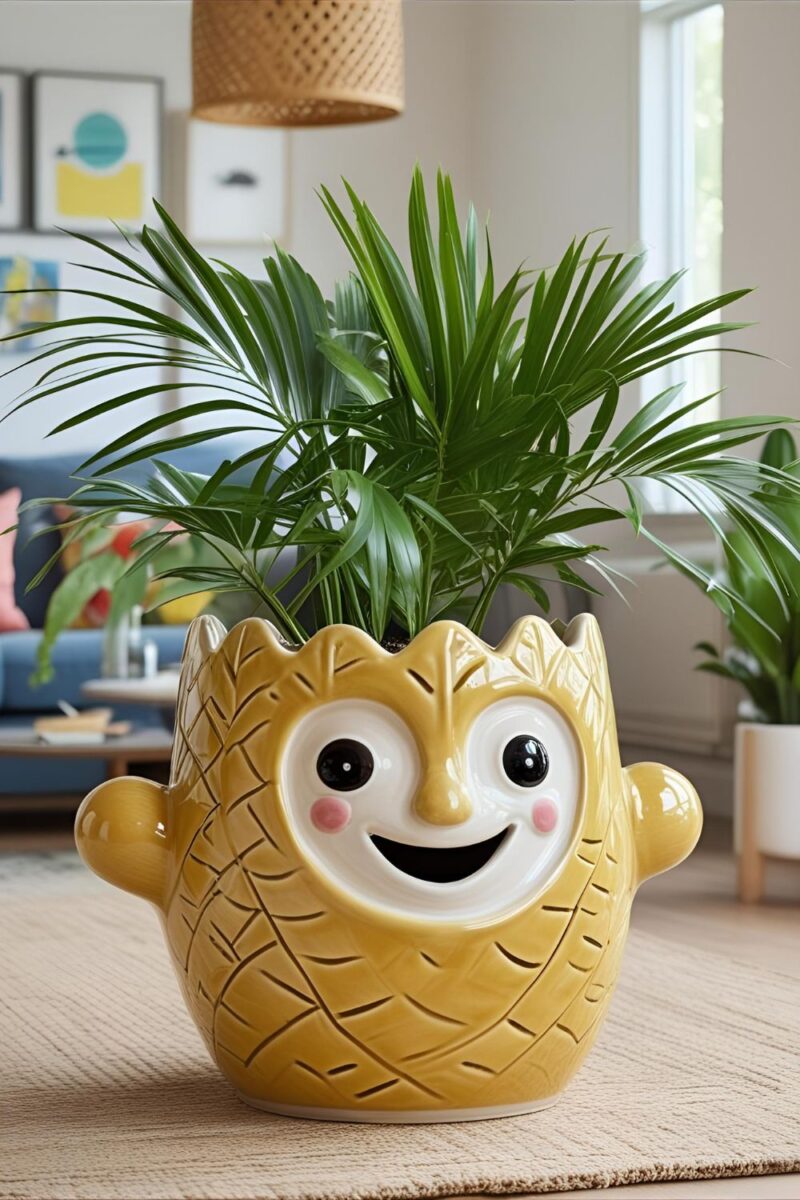
Statement planters are more than just containers.
They let you show off your style and add a unique touch to your home.
The right planter can turn your plants into decorative pieces that match your home’s decor.
Matching Container Styles to Your Home’s Vibe
It’s important to pick a planter that fits your home’s vibe.
For a modern home, sleek and minimalist planters in materials like ceramic or glass work well.
On the other hand, a bohemian-inspired space might look better with more eclectic, woven, or terracotta planters.
Think about the color and texture of your furniture and decor when picking a planter.
Weekend Projects: DIY Planters That Look Store-Bought
Making your own DIY planters can be a fun weekend project.
With a bit of creativity, you can create planters that look like they came from a high-end store.
Material Guide: Ceramic vs. Concrete vs. Woven
- Ceramic: Great for a sleek, modern look. Can be glazed in many colors.
- Concrete: Gives an industrial chic vibe. It’s durable and versatile.
- Woven: Adds a natural, bohemian feel. Can be made from different fibers.
Choosing the right material and style for your planters can make your plants stand out.
Whether you make your own or buy them, statement planters can turn your indoor garden into a beautiful display.
Tip #8: The Art of the Plant Gang: Grouping for Impact
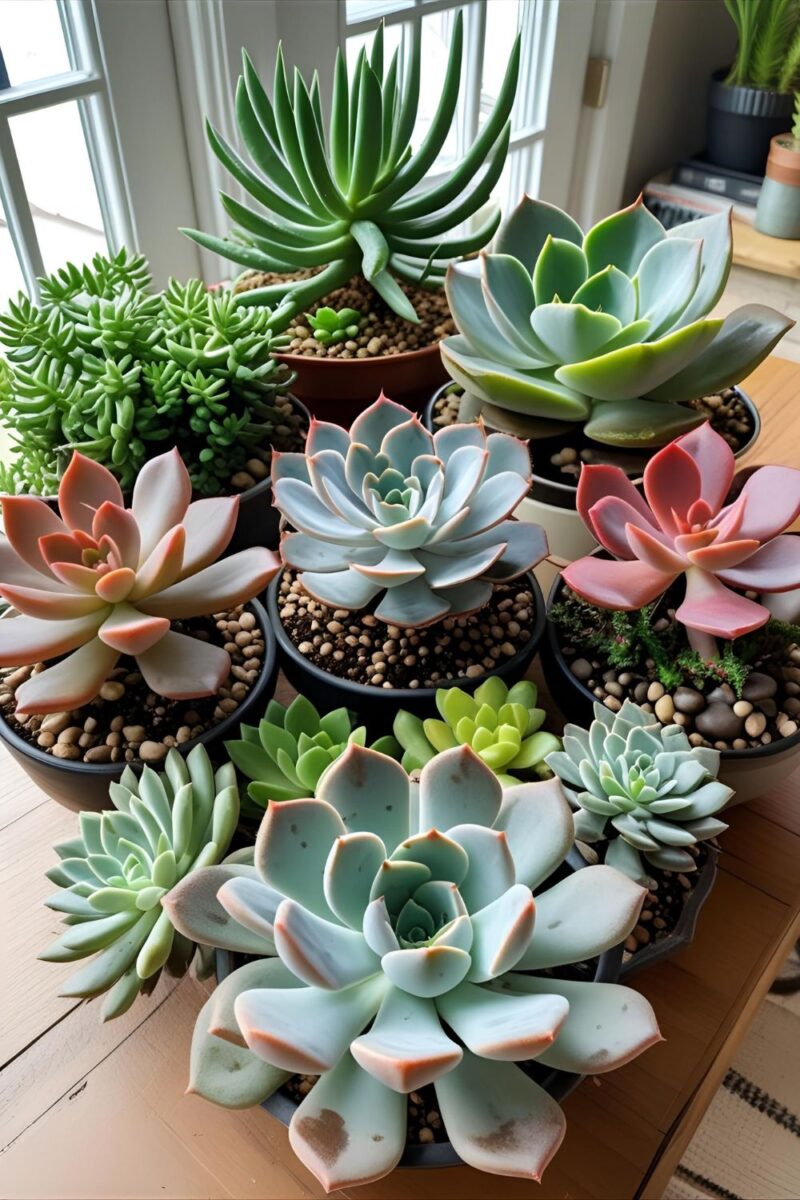
Grouping plants is a simple yet effective way to elevate your indoor decor.
Clustering plants together, you can create a visually appealing display that adds depth and texture to your space.
When done correctly, grouping plants can make a significant impact on the overall aesthetic of your home.
It creates a beautiful display and lets you play with different textures, heights, and colors.
Power in Numbers: Why Three Plants Beat One
Having multiple plants grouped together can be more effective than having a single statement plant.
This is because a group of plants creates a sense of abundance and can add a touch of lushness to your space.
The benefits of grouping plants include:
- Creating a visually appealing display
- Adding depth and texture to your space
- Allowing for experimentation with different textures, heights, and colors
Texture, Height, and Color: Creating Dynamic Plant Clusters
To create a dynamic plant cluster, consider combining plants with different textures, heights, and colors.
This will add visual interest and create a unique display.
| Plant Combination | Texture | Height | Color |
|---|---|---|---|
| Fern + Succulent + Flowering Plant | Delicate, fleshy, vibrant | Varying heights | Green, pastel, bright |
| Palm + Dracaena + Philodendron | Tall, slender, heart-shaped | Tall, medium, trailing | Green, variegated |
Plant Combinations That Always Work
Some plant combinations are tried and true.
For example, pairing ferns with succulents and flowering plants creates a visually appealing display with varying textures, heights, and colors.
Tip #9: Small Space, Big Impact: Plant Decor for Tight Quarters

Living in a small space doesn’t mean you have to give up style or plants.
With smart strategies, you can make even the smallest apartments feel lush.
The trick is to use your space wisely.
Vertical Solutions When Floor Space Is Premium
When you don’t have much floor space, the walls are your ally.
Vertical gardening lets you add greenery without taking up floor space.
You can use wall-mounted planters, trellises, or even DIY a living wall for a stunning look.
Think about using a modular shelving unit on a wall.
It’s great for plants and adds visual interest.
For a bold look, try a floor-to-ceiling living wall. It’s a real showstopper.
Compact Varieties That Pack a Visual Punch
Not all plants are right for small spaces. Compact or dwarf varieties are perfect because they stay small.
Plants like the Snake Plant or Pothos are great because they’re easy to care for and don’t grow too big.
Compact plants are also super versatile. You can put them on a desk, shelf, or even hang them.
This lets you try out different layouts until you find the perfect one for your space.
Multi-Functional Plant Displays for Apartments
In small apartments, everything should do double duty. Use plant stands that also work as tables.
You can also find planters with built-in storage to keep things tidy.
Another idea is to mix plants into your decor.
For example, put a small potted plant on a bookshelf or use a hanging planter above a doorway.
With a bit of creativity, even the smallest space can become a lush oasis.
Tip #10: Seasonal Switch-Ups: Rotating Your Plant Decor
Changing your plant decor with the seasons can make your home more interesting.
As seasons shift, your home’s lighting and temperature change too.
This is a great time to update your plant display.
Spring, Summer, Fall, Winter: Adapting Your Green Display
Each season needs different plants and setups. In spring, bright flowers like azaleas or tulips are perfect.
Summer is great for lush greenery and tropical plants.
For fall, choose plants with warm colors or berries. Winter is the time for evergreen plants and holly to add a festive vibe.
Light Changes and Plant Rotations Throughout the Year
Home lighting changes with the seasons. In winter, plants might need extra light.
In summer, they might need more shade.
Moving your plants to get the right amount of natural light helps them stay healthy.
Holiday-Specific Plant Styling Ideas
For Christmas, decorate your plants with ornaments or lights.
For Easter, use pastel pots or decorative eggs.
Seasonal decorations can make your home feel more festive and engaging.
- For spring, use brightly colored pots and planters.
- In summer, incorporate tropical plants and flowers.
- During fall, add warm-toned foliage and decorative gourds.
- In winter, use evergreen branches and holly for a festive look.
Tip #11: Living Walls: The Ultimate Plant Statement
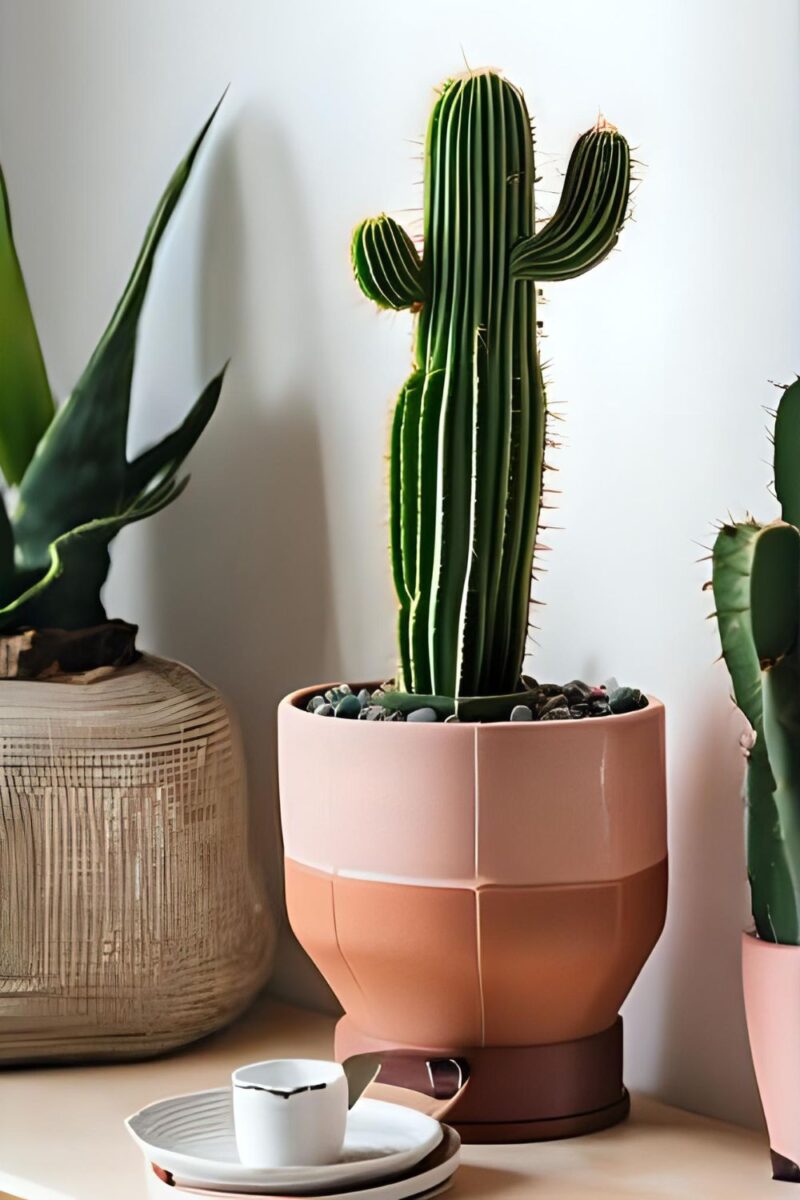
Turn your space into a lush oasis with living walls.
These vertical gardens bring greenery into your home.
They improve air quality and look great.
DIY Living Walls That Don’t Require a Contractor
Building a living wall is easy and affordable. You can make one yourself. Start with a wooden or metal frame.
Add a trellis or pockets for plants. Choose a good irrigation system.
Use plants that thrive in vertical conditions, like ferns or flowering plants.
Plant Superstars for Vertical Garden Success
Not all plants work well in living walls. Succulents, air plants, and vines are great. They need good air and can handle different light.
Maintenance Secrets for Thriving Living Walls
Keep your living wall healthy with regular care.
Water, fertilize, and prune plants. Make sure your irrigation system works well and check for pests often.
With the right care, your living wall will be stunning.
Living walls add a unique touch to your home. They’re perfect for plant lovers of all levels. Explore the world of indoor gardening with living walls.
2023’s Hottest Plant Decor Trends Worth Trying
The world of plant decor is always changing, and 2023 is no exception.
This year, people are finding new ways to add greenery to their homes.
They want their spaces to be beautiful and perfect for Instagram.
Beyond Fiddle Leaf Figs: What’s Trending Now
Fiddle leaf figs were popular, but 2023 is all about variety. Here are some plants that are trending:
- String of Pearls: A unique, trailing succulent perfect for hanging baskets.
- Prayer Plants: Known for their beautiful, unique foliage and vibrant colors.
- Air Plants: Epiphytes that don’t require soil and add a touch of whimsy to any room.
These plants are not only beautiful but also easy to care for. They’re great for people who don’t have a lot of time to tend to their plants.
Social Media-Inspired Plant Styling Ideas
Social media, like Instagram, has changed how we decorate with plants. Here are some ideas inspired by social media:
- Create a Plant Shelf: Use a shelf or bookcase to show off your plants. Mix different sizes and textures for a unique look.
- Use Unconventional Planters: Don’t stick to traditional pots. Try vintage containers, terrariums, or even macramé planters.
- Group Plants Together: Clustering plants can make a stunning display. It adds visual interest to any room.
Keep ‘Em Alive: Maintenance Tips for Gorgeous Plant Displays
The secret to a lush, vibrant indoor space is in the details of plant maintenance.
To keep your plants thriving, it’s key to know their basic needs.
Also, how to tackle common issues that may pop up.
Watering, Light, and Feeding: The Holy Trinity of Plant Care
Proper plant care is all about finding the right balance.
Too much water can cause root rot, while too little can make plants wither.
Most plants do best in well-draining soil and should be watered when the top inch feels dry.
Lighting is also super important, as different plants need different amounts of light.
Some love bright, direct light, while others prefer indirect or low light.
Knowing what your plants need is key to their survival.
| Plant Type | Watering Needs | Lighting Requirements |
|---|---|---|
| Succulents | Infrequent watering | Bright, direct light |
| Ferns | Consistent moisture | Indirect, filtered light |
| Snake Plants | Low watering needs | Low to bright, indirect light |
Troubleshooting Sad Plants and Quick Fixes
Even with the best care, plants can sometimes face challenges.
Issues like yellow leaves, pests, or slow growth can often be fixed with simple changes.
For example, if your plants are struggling, check the soil moisture, adjust the light, or look for pests.
Seasonal Care Adjustments to Remember
As seasons change, so do your plants’ needs. In spring and summer, most plants need more water and food. In fall and winter, water and feed them less to match their dormant period.
Conclusion
Starting a home transformation with indoor plants can change everything.
This article gives you 11 tips for making your home green and beautiful.
You can create a special plant corner or even a living wall.
Using these ideas, you can make your home look and feel new.
Indoor plants can make your space look better and even clean the air.
Begin your green journey today and see how plants can change your home.
With the right plants and some creativity, you can make any room lively and welcoming.
So, start your home makeover and enjoy the many good things indoor plants can bring.
FAQ
What are the benefits of having indoor plants?
Indoor plants clean the air, reduce stress, and improve mood. They also make your home look and feel better.
How do I choose the right plants for my home?
Think about lighting, temperature, and humidity when picking plants. Pick ones that do well in your home. Mix different plants for a nice look.
What are some low-maintenance indoor plants?
Snake plants, spider plants, and ZZ plants are easy to care for. They can handle forgetting to water sometimes and grow well in various light.
How can I style my indoor plants to create a cohesive look?
Match your planters and plants’ colors and textures. Group plants for a nice display. Use them to add color to a room.
Can I use indoor plants in my bathroom?
Yes, but pick plants that like humidity, like ferns or orchids. Make sure they can handle your bathroom’s light.
How often should I water my indoor plants?
Watering depends on the plant, its size, and where it’s growing. Check the soil moisture with your finger. Water only when it’s dry.
Can I propagate indoor plants to create new plants?
Yes, many plants can be propagated. Learn the right method for your plant, like leaf or stem cuttings, division, or layering.
How can I keep my indoor plants pest-free?
Check your plants often for pests. Isolate new plants before adding them to your collection. Use natural pest control and avoid too much water.

